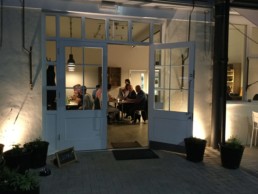Cambridge's first zero food waste business
As a small, independent food business on a mission to widen the love and support of sustainable food, we promote the One Planet Living ethos. We reached zero waste by being counter intuitive. We now take in ALL no longer sellable local, organic produce, add to it our own very limited amount of food waste and turn into 30 weekly meals for our local homeless shelter Jimmys.
The Contemplations - an interview with Tine Roche, Founder of Cambridge Cookery
In early July, we were lucky to be joined by Laurie Parma, Founder of LifeCloud & wellbeing researcher, as part of her series of interviews, 'The Contemplations'. Laurie studied neuroscience in Bordeaux as well as here in Cambridge, and she came in to speak with our founder, Tine Roche, about her journey into the culinary world, the background of Cambridge Cookery and how Tine came to set the school and cafe up.
Hear Tine talk about food trends, the history of the increasingly popular food trucks, and how travelling to the USA helped to inspire her interest in cooking, baking and, in particular, bread. It's 15 minutes of inspiring food talk, what are you waiting for!
Best British Fizz & canapé tasting Friday 24th November 6.30-8.30pm
It is such a shame that British fizz can't be called Champagne as it is made using the same method and is starting to score higher than the French champagnes in international wine tastings. We were introduced to cult East Sussex brand Fox & Fox last year and we were hooked after the first sip. Frequently scoring top marks in the wine press, this small, quality brand makes white and pink sparkling wines with strong characters.
Come along and meet Jonica Fox, the talented wine maker behind the brand and indulge in no less than 5 glasses of this outstanding wine, as well as an array of our delicious canapés.
We have secured a limited amount of cases which will be available to purchase on the night.
Call or email us to book a space.
Yum Cha pre-Christmas event with a sparkle!
Extraordinary chef Lilian Hiw, formerly of legendary Raffles Hotel in Singapore, pop ups for a sparkling Yum Cha!
Yum Cha is a cantonese and means "drink tea"
The tea is key - usually a selection of green, black, smoked and chrysanthemum but we are plan something a little more exotic...
The tea accompanies Dim Sum and if you think you have tasted good Dim Sum, wait until you try chef Hiw's outstanding hand crafted smoked, steamed and barbecued Dim Sum
The 5 course menu includes welcome cocktail and tea
Jade Bamboo
Freshly brewed green jasmine tea with rum and organic honey, shaken with a squeeze of fresh lime juice
"Blooming Tea"
Steamed prawn & pork siew mai
Deep fried chinese five spice wontons
Baked BBQ char siew puffs
Wok smoked drunken chicken noodles
Cantaloupe melon, tapioca pearls and coconut dessert
45/pp
For parties of 4 or more, 40/pp
Children eat for 1/2 price
Call or email us to book!
Table reservations
Weekends are very busy at Cambridge Cookery. It starts on Fridays, which now require table bookings for brunch and lunch if your party consists of 4 people or more, and carries on through Saturday and into Sunday afternoon. Brunch is exactly the leisurely experience we want it to be, with guests following their savoury favourites with a helping of our much talked about fluffy pancakes, ordering a second Flat White and reading the papers.
Our no choice, Saturday night local and seasonal menu, which includes a welcome drink, has become such a success that tables are booked weeks in advance. Our chefs are lead by the seasonal produce we receive from our organic and local producers and the menu can be enjoyed in its entirety or as a 2-course meal. Children eat for half the price.
When we opened the Bistro last year, we aimed to be a relaxed and welcoming neighbourhood restaurant and that is exactly what we have become.
Chloë performing in the Café Saturday 16th September
Our very own Chloë Millard has created new material which she will perform on the terrace during Brunch on Saturday 16th.
Don't miss this local talent!
May article for Cambridge Magazine
May, infused with the heady scent of lilacs, heralds the arrival of tender produce such as fresh peas, broad beans, radishes, rhubarb and the sublime Jersey Royal potatoes.
Crab is at its best and lamb adorns most menus. The concept of eating lamb early in the season, for Easter and in early May, derives from the fact that lambs were traditionally born in late winter, so they could eat the new grass as soon as they'd finished their mother's milk. The sweetest and tenderest was spring or new lamb fed only on its mother's milk. "Spring" means an animal born early in the same year, and slaughtered at about four months.
Lamb sold as early as Easter will have been born in midwinter, and "finished" on a diet of hay or a cereal-based manufactured feed. The wise cook will wait for the arrival of June and July to cook lamb. This will mean that the animals were reared first on mother's milk, then from 4-5 weeks on fresh grass. Grass-fed meat is healthier than cereal fed. It is lower in fat and higher in Omega 3.
Long celebrated in France, we are catching up on the delicacy that is salt marsh lamb, usually from north Wales but increasingly also from the Essex marshes. Born between March and April, the animals graze on the estuary salt marshes and coastal pastures that are flooded by the spring tides and doused by the sea. The lambs feed on plants and minerals growing in the salt marshes which results in richly flavoured meat with a hint of samphire and sea lavender. The iodine-rich content of these plants and grasses also infuse the muscle cells in the flesh so the meat is juicier and more tender. The added benefit is that the salty water kills a large number of bacteria that can be harmful to sheep and so the need to treat the animals with chemicals is considerably reduced.
So don't rush out to buy lamb quite yet, wait another month or so and seek out Romsey or Welsh salt-marsh lamb just in time for the barbecue season.
When I first saw sheep grazing so close to the sea I wondered how they kept from being caught up in incoming tides. I have since learnt that older ewes sense when the tide is coming in and lead the flock to higher ground and then when the tide goes out, lead the flock back to the marshes. Clever girls.
Having eaten my fill of local asparagus thoughout the month of April, I am ready to turn my attention to one of the most delicious things to come out of the earth - new potatoes from the steep slopes of Jersey. I grew up in Scandinavia, where the humble potato is a staple of the cold climate diet. New potatoes come into season a good 5-6 weeks later than in the UK, at the height of mid summer. As a result of the very long days, the flavour is exceptional. The closest thing to it in flavour are Jersey Royals. They don't need much done to them - they should be enjoyed in their purest form. Simmered, scrubbed skin on, in well salted water and served with dollops of butter they are quite simply one of the most moreish things one could possibly eat. Roasted in olive oil, with sea salt, rosemary and lemon zest they make the perfect accompaniment to any roast fish, fowl or four legged. Simmered, then roughly crushed, or smashed, with a fork, with added butter, salt and pepper, and served with a freshly made chive or dill oil, they are a wonderful companion for smoked, grilled or pan fried mackerel.
For those preferring to put a bit more effort into their cooking, spring Bubble & Sqeak should satisfy. Mix finely chopped, cooked new potatoes with chopped spring onions, tender double podded broad beans - that is, outer grey-ish "jacket" encasing each bean removed to expose the emerald green inner bean - green peas, dill or parsley. Season well, shape into small patties and fry in sunflower oil and a little butter until crisp. I would serve with a very soft poached egg.
Radishes should be enjoyed as fresh as possible, while retaining their crispness and heat. They look and taste lovely, thinly sliced in green salads or presented simply, in a bunch, with their foliage still on. In the café we currently top our popular open rye sandwiches with Danish "Summer Salad" - sliced radishes, chopped chives and cucumber stirred into thick yoghurt and seasoned with a little lemon juice, sea salt and pepper. But, the simplest is often the best: on the first hot day, have them for lunch, paired with dense, dark Pumpernickel, cold butter, sea salt and a fridge-cold bottle of salty lager.
.
Spearheading
I am going to be unashamedly unoriginal and write about the obvious - which happens to be one one of my annual favourites - asparagus.
We live in one of the country's best asparagus growing regions and here at the Café and Bistro we like to show our love of the local spears by putting them on the menu every single day throughout their all too brief 5-6 week period of being "en primeur". Once the season comes to and end, we feel we have done them proud and are content not to cook with asparagus until next spring. By taking this approach to British fruit and veg, we are able to support our small, local suppliers. We were bemused by the courgette and salad "crisis" earlier this year. Any growing area can be struck down by bad weather and this will inevitably lead to a shortage of produce. Tender salad leaves and courgettes will be coming into season here in the next few months, and that is the time to enjoy them. Nothing matches the superior flavour, texture and nutrient levels of produce which has been recently harvested, as opposed to having spent 48 hours in a chilled lorry, journeying across Europe.
To paraphrase the verbally challenged former POTUS, George W Bush, there is no word for "en primeur" in the English language. Sadly, this also means that there is no real tradition of celebrating the arrival of a new fruit or vegetables the way most other parts of Europe do.
Few British crops deserve to have their arrival on the culinary scene announced by drum rolls and fanfares more than asparagus.
The tender spears can put on up to 30cm growth in a 24-hour cycle, making the brief season a rather stressful period for growers. No sooner has one lot been harvested than new rows of calf-high spears call for attention.
Freshly cooked, new season asparagus have a sweet, yet sharp grassy flavour, unlike any other vegetable. Eaten raw, the flavour is a shock to the taste buds, so identical is it to the taste of freshly shelled green peas. We like the taste of raw asparagus so much that we add shavings whenever we can in our salads, teaming it with tender broad beans, lemon, mint and fresh goats curd.
Different cooking methods will bring out quite different aspects of flavour. What won't be affected by the cooking method is the immediate and unavoidable effect on bladder content. It takes only one spear to add an unmissable whiff. For those in love with asparagus, it is a well known consequence but nevertheless one which tends to cause a jolt of surprise very single time.
Swiftly moving on to matters more sophisticated, musing on which wine with which to partner ones asparagus is a joy. The go-to grape tends to be Sauvignon Blanc, on account of its high acidity and very similar flavour to asparagus. However, depending on how the spears are cooked, this is far from the only wine choice.
If the spears are served cold, with a white wine vinaigrette, it is important to find a wine which can cope with the extreme acidity yet won't compete with the delicate flavour of the asparagus. We like to pair asparagus vinaigrette with our house Italian, a clean Verdicchio from our Producer Vignamato in Le Marche. We chose this white from one of our small team of Producer precisely because it makes such a good accompaniment for all things acidic and citrus. We use both liberally it in our salads and our Japanese and Swedish influenced food. The clean, crisp fruit driven Verdicchio is perfect for that.
When matching asparagus with melted butter, egg or mayo, the increased richness welcomes crisp, unoaked Chardonnay such as a good Chablis.
Going the full emollient hog with Hollandaise or soft-boiled or poached eggs to dip the spears in - an oaked Chardonnay from the heart of Bourgogne or even a Champagne is a great match.
We have been busy creating a 5-course menu for our big April Food&Wine event, featuring our partners Suffolk Vineyards. The third tasting dinner in our spring series, this is possibly the most exciting, as we are bringing to Cambridge the artisan house of Fox&Fox from Sussex.
For us it was love at first sight when we were introduced to this small scale "méthode Champenoise" fizz. We are particularly excited about matching their amazing pink, a saigné with added savoury depth from Pinot Noir, as an accompaniment to new season lamb, tender chicken and Italian "Coppa" - similar to Prosciutto, but better, and made not from the ham but fom the collar and, in our case, sourced from our wonderful suppliers of high welfare meat up in Rutland.
With so amuch amazing British produce to enjoy, who needs imported salad leaves?
Wine Dinners with our Producers
February and March saw two hugely successful 5-course Dinners with wine tasting and talks by the owners of Fattoria Mancini in Le Marche and Coopers Creek in New Zealand.
Next up on Friday 21st April is Sussex Vineyards Fox&Fox whose superb, boutique Champagnes we are proud to stock. Gaining a lot of attention from the wine press, this small, artisan Producer is making outstandingly good Fizz.
Owner and wine maker Jonica Fox will present her wines along our 5-course spring menu.
We are a Slow Food business and we only work with with a handful of producers whom we know personally and include in our culinary trips. Our wine list is small and quirky, our food is based on what we are supplied by small and local producers.









